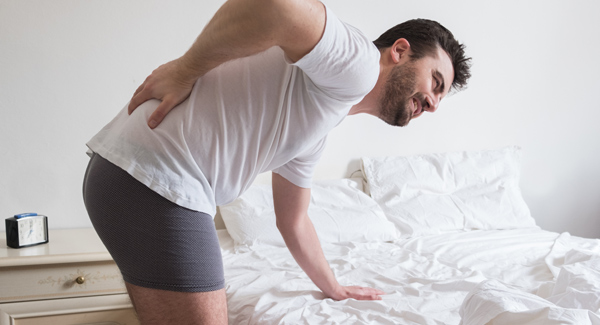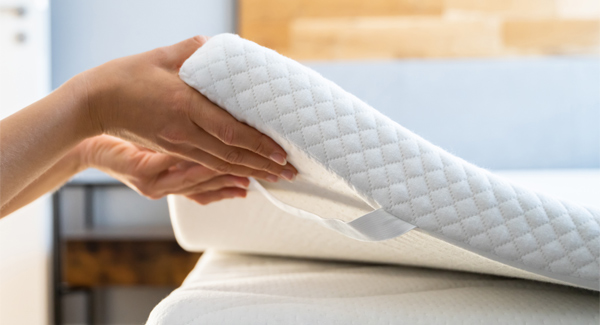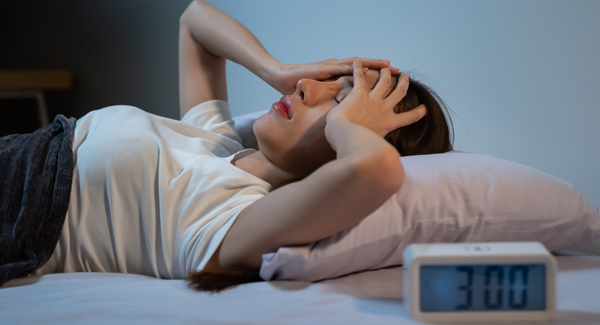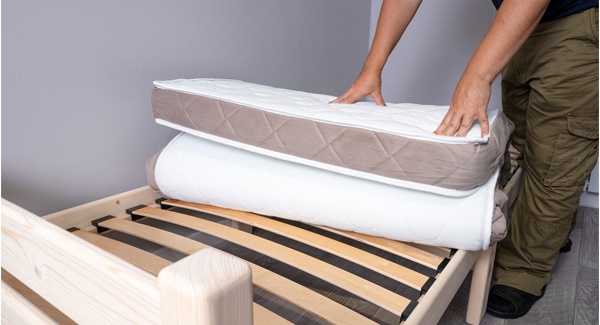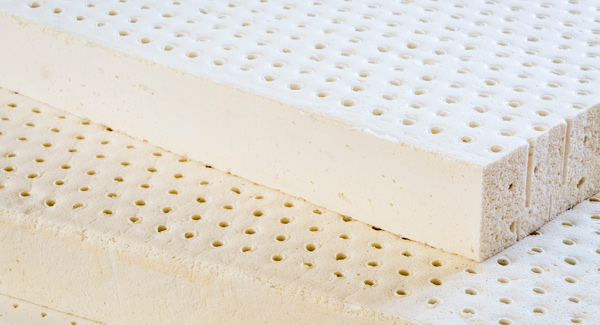Home » Mattress advice » Is A Firm Mattress Better For Your Back?
Is a firm mattress better for your back?
Article navigation
- Tony Brown
Shopping for a new mattress can be a daunting prospect, especially if you are unclear about the options available. Many people often turn to friends and family for recommendations or look for information online.
The problem with this is that the information may be unreliable or outdated. Furthermore, comfort is subjective. What’s right for one person may not be right for someone else.
There is a common misconception that a firm mattress is better for your back. In the past, medical professionals, such as doctors, chiropractors and physiotherapists, would often recommend firm mattresses for a bad back. Some would even suggest placing a sheet of board underneath the mattress to make it feel firmer.
This is not necessarily the case. Various studies suggest that a firm mattress can contribute to poor quality sleep. It can also restrict blood circulation, cause pressure points, aches and pains.
The best type of mattress for a bad back is one that you find comfortable and that supports your body correctly. Besides your comfort preference, you should also consider your body weight as one of the main factors when choosing a new mattress. Generally, the heavier you are, the firmer the mattress you need, as shown in the table below.
| Body weight | Recommended mattress tension |
|---|---|
| Someone that weighs up to 11 stone (70kg) | Soft |
| Someone that weighs between 11 and 16 stone (70 to 102kg) | Medium |
| Someone that weighs 16 stone and above (102kg +) | Firm |
What happens if your mattress is too firm?
If your mattress is too firm, this can cause pressure around the shoulders, hips and knees. It can also reduce blood circulation and cause numbness, aches and pains. A firm mattress prevents the body from sinking into the mattress due to its lack of cushioning. This can be particularly problematic for side sleepers as the resistance that the mattress provides can cause discomfort around the shoulders and hips.
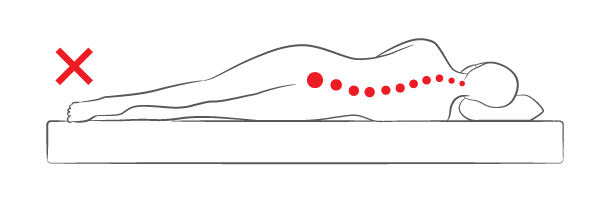
On the other hand, a mattress that is too soft will put the spine out of natural alignment, causing the body to slouch. This can also cause discomfort and make it harder to turn over in bed.
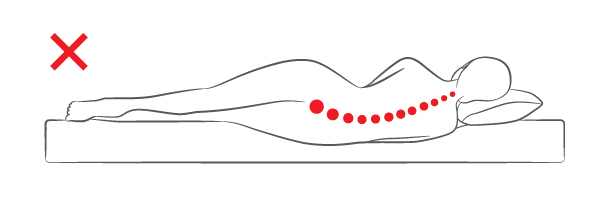
A mattress should conform to the body’s natural curves and put minimal stress on your joints.
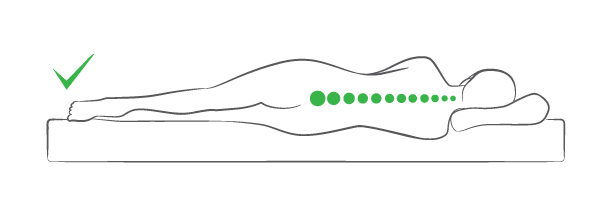
Discomfort
If you find yourself waking up in the middle of the night, or you’re actively tossing and tossing because you’re uncomfortable in bed, it could be an indication that your mattress is too firm.
Likewise, waking up with soreness, aches, pains and pins and needles could also be a sign that your mattress is doing more harm than good.
Spinal misalignment
A firm mattress can cause misalignment, causing the spine to bow upwards. The body is not relaxed and the resistance from the mattress may cause tension and pressure points.
Pressure points
A firm mattress can aggravate pressure points, which are the areas of the body that come into contact with the mattress. Pressure points can vary depending on your sleeping position. For instance, side sleepers may experience pressure on their shoulders and hips.
Lack of circulation
Since firm mattresses provide little to no cushioning, this can also restrict circulation around the body resulting in pins and needles and numbness.
How to tell if a mattress is too firm
A handy check to determine whether a mattress is too firm is to lie on your back and slide your hand between the mattress and the hollow of your back. The mattress is probably too firm if your hand slides underneath easily.
If you struggle to slide your hand underneath, it is probably too soft. Ideally, you should be able to slightly slide your hand underneath your back with a little bit of resistance. This would indicate that the mattress is providing the correct level of support.
What type of mattress is best for back pain?
Be wary of mattresses described as orthopaedic or posturepedic. These terms describe firm mattresses and can often mislead people into thinking they are suitable for a bad back. These mattresses can often make a bad back worse instead of better.
There are several types of mattresses that may help to alleviate back pain. Weighing up the pros and cons of each type will help you determine which is best for you.
Pocket spring
For sleepers that prefer the feel of a sprung mattress, pocket springs offer superior support, comfort and durability compared to other sprung mattresses.
Pocket springs are individual springs encased in fabric pockets and stitched together. Each spring works independently, conforming and adjusting to the body’s shape and ensuring that weight is evenly distributed.
Typically, the higher the spring count, the more supportive the mattress will be. But, some mattresses contain mini springs, which enhance the overall spring count. Mini springs provide an extra layer of comfort but are not as supportive as full-height springs. This means that comparing spring counts between different manufacturers can often be misleading as you won’t know if you’re comparing mini springs with full height springs.
Many pocket spring mattresses are available in a choice of soft, medium, firm and extra firm spring tension to suit your requirements. Sleeping partners of vastly differing body weights and build may benefit from a split tension mattress. This allows each partner to have their side of the mattress in the spring tension of their choice, for instance, one side soft and the other side medium, or one side medium and the other side firm.
Similarly, zip and link beds allow each partner to have their bed in a mattress tension of their choice. Zip and link beds can be either zipped together when sharing or separated to create two single beds.
Memory foam
Memory foam moulds and adapts to the body’s shape. It can help relieve pressure and improve circulation. Unlike sprung mattresses, most memory foam mattresses do not require turning, making them easier to maintain. However, they may benefit from being turned from time to time to help out even out the wear.
Due to its dense cell structure, some memory foam mattresses may feel warmer to sleep on than other mattress types. But, many manufacturers have adapted their mattresses to counteract this and help to regulate your body temperature.
Latex
Like memory foam, latex contours to your body shape and has good pressure relieving qualities. Natural latex, in particular, is breathable, durable and recovers its shape quickly as pressure is removed. Latex is slightly bouncier than memory foam, making it easier to turn over in bed.
Hybrid
As a compromise, hybrid mattresses offer a best of both worlds solution by combining either memory foam or latex with springs. Hybrid mattresses are ideal for people looking for a traditional sprung mattress with the comfort and pressure-relieving benefits of foam.
Try before you buy
To help ensure that you choose a mattress that provides the correct support, you should ideally try out mattresses in a showroom. The benefits of visiting a showroom are that you can see and feel the mattresses, but most importantly, lie down on them to see which provides the comfort and support you need. Furthermore, you’ll be able to discuss your requirements with the sales advisor, allowing you to evaluate your options better.
If you prefer to shop online, make sure you buy from a company that offers a mattress trial period that allows you to return the mattress if you find it uncomfortable.
Final thoughts
Comfort is subjective, which is why you should be wary of advice from friends and family or what you read online about choosing a new mattress. It is a common misconception that a firm mattress is better for the back. Correct support depends primarily on your weight and build. Generally, the heavier you are, the firmer the mattress you need.

About the author
Tony Brown is the founder and creator of The Bed Consultant. His career in the bed industry began in 2002. After graduating from university with a degree in Business Administration, Tony joined one of the largest independent furniture retailers in the UK as a bed consultant. Tony has helped thousands of customers find the perfect mattress.

